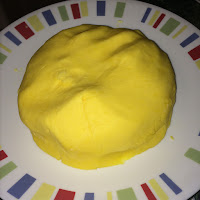One of the basic staples in my classroom is playdough.
I almost always have playdough, or a similar material available daily. I use a
homemade cooked playdough recipe (more about that here), that’s flour based.
One the downsides of homemade and many store bought playdoughs is that because
of the flour, children who are gluten free or have a wheat allergy can’t use
it, and in an allergen aware classroom, it might not be allowed.
So I tried out some different dough recipes that didn’t
use flour. Many of them made different goop concoctions, which can be rich
sensory activities, but they don’t have the same properties as playdough.
Finally I found this one – a cooked recipe of cornstarch and baking soda. Even
if you don’t have any restrictions that keep you from using a flour based
dough, it’s nice to provide the children with materials that have various
textures. This dough is slightly softer than traditional flour-based playdough,
and feels cooler to the touch (similar to cornstarch goop), but holds up just as
well during play and has a similar shelf life.
Here’s the recipe:
1
cup cornstarch
2
cups baking soda
1-1/4
cups cold water
1 tablespoon
vegetable oil
1
tablespoon food coloring
Mix
all ingredients together over low heat until the dry ingredients all dissolve.
Keep stirring for about 5 minutes until it starts to bubble.
Once
it bubbles, it will start to thicken slowly. Keep stirring for another 2 or 3
minutes.
If
you’ve ever made cornstarch goop, the mixture will have the same properties as
it cooks, looking solid, then turning liquid when you try to pick it up.
Soon
it will start to solidify. It will look like mashed potatoes or grits.
When
it turns solid and starts forming a ball, take it off the heat and let it cool.
Store in a sealed container.

























